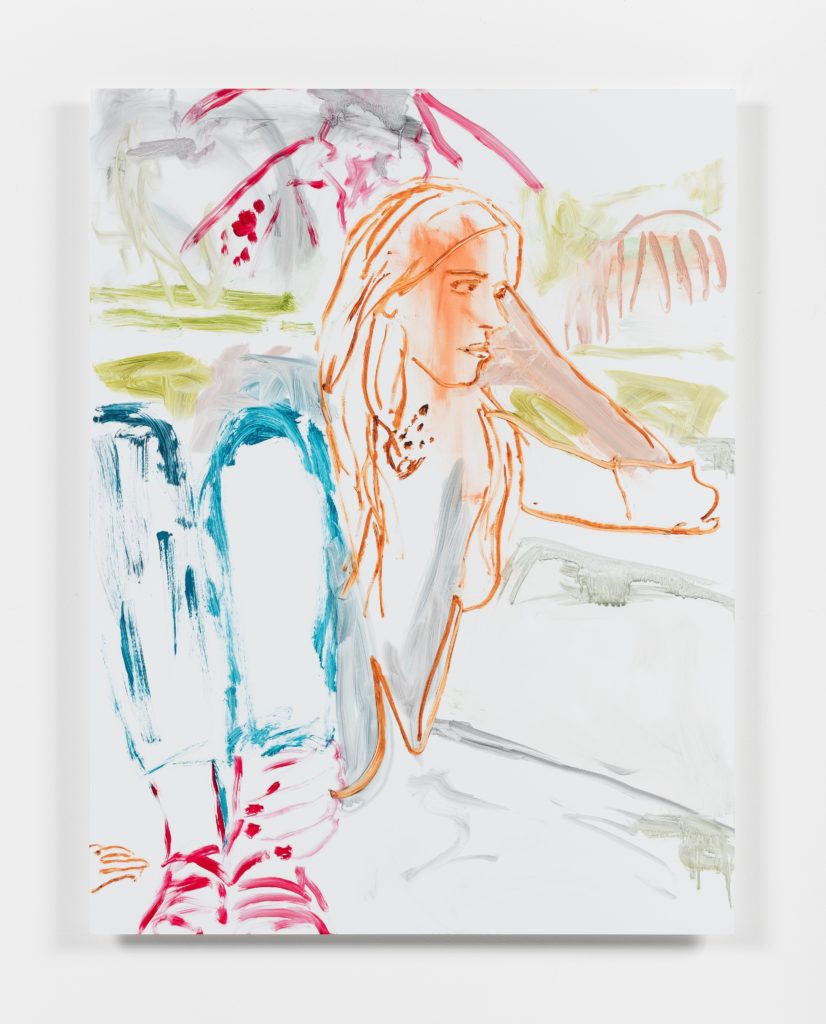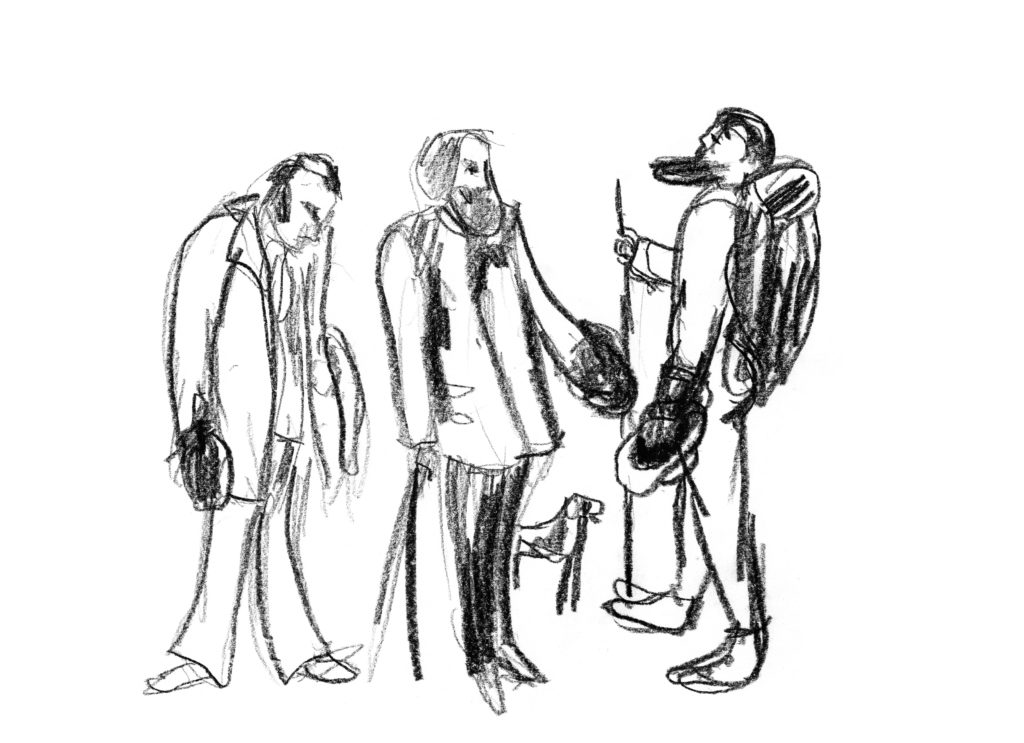It’s not often one disputes the origin of the signature brushstroke, especially if it is from a living source. Reena Spaulings is not a person but a fictional character, emerging from the cult book of the same name, then a gallery in New York co-directed primarily by artists John Kelsey and Emily Sundblad, among others. Atypical in the human sense, she was birthed from a writing process by unknown writers and artist in 2004, and is now part persona, part gallery and part anonymous collective. She does not comply with the normative reality of painting production, either by method or means.

In the book, Reena Spaulings is a 20-something woman who is discovered whilst working a nine-to-five job as a museum guide, only to become a rich and successful international supermodel-cum-artist later on. Those years are what is being presented at Her and No, running at Cologne’s Museum Ludwig, June 3 to August 27. The exhibition is made up of a series of painted canvases and found objects, the palette is predominantly dirty pink, orange, purple, yellow and green (the oils look like they came straight from the tube in a furor, not delicately mixed for that individual colour set). The works on show overload the eyes in a sort of controlled anarchy, both ugly and decadent they throw out art history references — ‘patron as model’, ‘man with dog’, ‘cathedral landscapes’ into the frame, in a sly comic fashion. But the pieces are secondary to what is enticing about Spaulings, she embodies what the viewer can only believe they witness, she is a novelty in painting and art production.

Post 9/11, Reena Spaulings was ‘founded’ as the perfect phantom protagonist co-authored by Bernadette Corporation, an art and party collective formed by Bernadette van Huy, Kelsey, and Antek Walzcak at Club USA, a notorious avantgarde venue that existed in the mid-90s at an old theatre near a then seedy neon-lit Times Square. BC’s club night ‘Fun’ aligned with but was different from Michael Alig’s notorious Club Kids crew. The latter were more drag, and prolific ketamine-use and bad behaviour was their mantra. BC’s gender-bending, political rhetoric was packaged inside contemporary performances and forms, leaving the club earlier than Alig and wandering into the art world, tripping over anarchist literature en route. The work they created engulfed fashion and art, producing a unique interface that managed to seamlessly blend black bloc anarchist theory onto pop culture rationale. Since then, Spaulings the artist has ghost-directed a commercial gallery under the name Reena Spaulings Fine Art, which coincidentally represents Bernadette Corporation, as well as the ambiguous advocate Claire Fontaine, among others. Fontaine had been a duo of artists who emerged from the anarchist Collective The Invisible Committee, who penned the famous French book The Coming Insurrection, a political tract that hypothesizes the “imminent collapse of capitalist culture.” This is just one of the vivid conjunctions that Spaulings creates in her pseudo meta-living. The fabricated figurehead, also moonlights as an artist alongside her successful career as a gallerist, and this is exactly her role in the new solo show. It is the first museum collaboration that she has done, normally showing only in commercial spaces and art fairs. The three vast rooms that have been given over to the quick-witted, yet sombre show have a booth-like quality reminiscent of art fairs. Perhaps, the only natural space for Spaulings is the unnatural world of the art economy, where sunlight never reaches the wares. She did, after all, start her life off in the museum, according to the book, only to become a thong model and blow her haughtily acquired earnings on very little in a charmingly annoying, naive and docile manner.

Three freestanding, larger-than-life aluminium panels are the most arresting works in Her and No, they frame it as a subjective depiction not only of their own painterly forms — which in this case is a remix of Gustav Courbet’s 1854 realist oil painting ‘The Meeting (Bonjour, Monsieur Courbet)’ — but also the collective effect of money-enabling inspiration and thus creation. In the 19th century original, the artist depicts a countryside hike, to which he runs into Alfred Bruyas, a well-known collector and patron of Courbet’s. They exchange greetings cordially amongst the grassy pastures. Reena Spaulings illustrates the scene with a more contemporary palette of metal, oils, acrylics and found objects, including a humorously odious addition of a fidget spinner. That small detail echoes the infantilism habits and ‘whatever’ culture of Club USA, while showing that little has changed over 20 years later. Youth culture is still unimpressed and bored by life. Courbet himself captured his character as one filled with self-confidence and pride. When Spaulings revisits this piece, she delicately assumes the position of witnessing the role of the painter and the funding body, both in the past and the present. The work points outright to the soft power tactics that float between the artist and their dependence on the market, in pursuit of fame and recognition, not only for the producer but also the collector, the buyer and the institution.

Interestingly, the group behind Spaulings does not have a day-to-day collective practice. They only come together to work on commissions, while having their own individual artistic engagements. In the case of Her and No, the collective had one year to work on the show, which curator Ania Czerlitzki says is a rarity. Normally they meet in an offline, real-time space and collectively develop, paint and critique in a frenzy of speed before the opening only a few weeks before. Each work is jointly created, in doing so contesting the infrastructure that is traditionally applied to the star painter in a neoliberal art world from within. There are other contemporary projects that also spoof this rhetoric — DIS Magazine, for example — but what still holds the enthusiasm of this act in Spaulings’ work is that even when something is as traditionally-ladened and marketable as painting, the cultivation of the solo self is made redundant in the mythical collectivity of her collaborators. One clear abstraction of a once-conventional methodology is Spaulings’ use of pointillism. In the show, various canvases ascribe to this technique developed around the 1880s, which uses small, distinct dots of colour applied in patterns to form an image. In Spaulings’ case it’s the New York Herzog & de Meuron-designed luxury condo skyscraper on 56 Leonard Street, often described as the ‘Jenga building.’ This method of neo-impressionism had a heavy anarchistic flavour to it in its day, which could explain another draw to the craft from the collective. The most prominent pointillist artists, Georges Seurat, Paul Signac and Jean Grave, all attested to anarchist ideology alongside their aspirations toward achieving the unreal through their depictions of microdots as life. What is also perhaps important to note here, is the way in which pointillism also delineated the artist’s touch from the product — there is no signature to a dot, it’s more reflexive than cultivated, one dot on its own is as unique as any other dot. To the human eye, one Spauling’s collaborator’s dots are indistinguishable from another’s, together they mask their individuality in favour of collective production. A key component to the advancement of disorder being due to the absence of authority or a singular controlling system, is perhaps the illicit message in the works.

Reena Spaulings as a concept has been criticised for exactly this oxymoronic gesture, questioning whether one can be with the system and against it in the same autonomous brush stroke. This position is relative to who witnesses this act of authoritative fact or fiction and who benefits from it. Kelsey and Sundblad are hardly hippie idealists. They understand they must play the system to survive. To double-bluff is an act of fiction that cannot be localised or specifically truth-founded — there is no fact in art production, this lends it the potential for mobilisation in this oppressively rigorous world. The art world mockingly seeks the authentic — but we all know that art goes against notions of the authentic in favour of inspiration and abstraction, like an eternal fidget spinner spinning endlessly on its own axis, idle but at rapid speed. Art interprets life and life interprets art. By Spaulings appropriating realism and pointillism in the same body of work, we see it as one self-consuming serpent, just as we know free-market strategies are. In a world of fake news, memetics, parasitical propaganda, and the imperturbable routine of capitalist normality, the only objective position left is surely collective imagination. The Left has to bend the phenomena of the absolute, even in something as seemingly unrelated as painting. Today’s insurgencies are as visible or as invisible as the naked eye makes them. Reena Spaulings allows you to look beyond the canvas and into the direct action of painting, enabling a potential view to another history.**
Reena Spaulings’ Her and No is on at Cologne’s Museum Ludwig, running June 3 to August 27, 2017.













